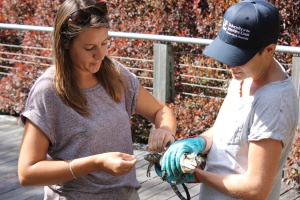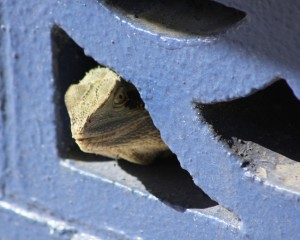
In this Insight, Bethan Littleford-Colquhoun, a researcher at the University of the Sunshine Coast, Australia, talks about her recent paper, How sexual and natural selection shape sexual size dimorphism: evidence from multiple evolutionary scales.
What’s the paper about?
 This paper (Littleford‐Colquhoun, B. L., Clemente, C. , Thompson, G. , Cristescu, R. H., Peterson, N. , Strickland, K. , Stuart‐Fox, D. and Frere, C. H. (2019), How sexual and natural selection shape sexual size dimorphism: evidence from multiple evolutionary scales.doi:10.1111/1365-2435.13337) explores the drivers of differences in male and female body size by looking at how different processes (natural and sexual selection) interact at the species level, population level and the individual level. To investigate this, we used data from Australian agamid lizard species as they display large inter-species variation in size between the sexes.
This paper (Littleford‐Colquhoun, B. L., Clemente, C. , Thompson, G. , Cristescu, R. H., Peterson, N. , Strickland, K. , Stuart‐Fox, D. and Frere, C. H. (2019), How sexual and natural selection shape sexual size dimorphism: evidence from multiple evolutionary scales.doi:10.1111/1365-2435.13337) explores the drivers of differences in male and female body size by looking at how different processes (natural and sexual selection) interact at the species level, population level and the individual level. To investigate this, we used data from Australian agamid lizard species as they display large inter-species variation in size between the sexes.
 Overall, we found that different processes were more important at each evolutionary level. For example, at the species level, population density, ecological generalism (the number of climate zones a species occupies) and mean species size significantly predicted sexual size dimorphism. Yet, among populations of water dragons inhabiting different city parks and native bushland, density positively correlated with sexual size dimorphism in native habitats, but not city park habitats. Lastly at the individual level, aggressive behaviour acted as the primary driver of sexual size dimorphism.
Overall, we found that different processes were more important at each evolutionary level. For example, at the species level, population density, ecological generalism (the number of climate zones a species occupies) and mean species size significantly predicted sexual size dimorphism. Yet, among populations of water dragons inhabiting different city parks and native bushland, density positively correlated with sexual size dimorphism in native habitats, but not city park habitats. Lastly at the individual level, aggressive behaviour acted as the primary driver of sexual size dimorphism.
 Celine Frere and I came up with the idea for this paper whilst drinking coffee waiting to catch a plane out of Melbourne. Dr Frere’s lab group have been studying populations of eastern water dragons in Queensland, Australia for the last 10 years and over that time we’d noticed that the difference in size between males and females varied depending on population, with this sexual size dimorphism seemingly more pronounced in city park populations. This got us thinking about the different drivers of sexual size dimorphism across populations, as well as within populations. The idea then then grew from there and luckily we have some great collaborators who had access to morphological data from many other agamid species. This additional data allowed us to then explore the drivers over the different evolutionary scales: species, populations and individuals.
Celine Frere and I came up with the idea for this paper whilst drinking coffee waiting to catch a plane out of Melbourne. Dr Frere’s lab group have been studying populations of eastern water dragons in Queensland, Australia for the last 10 years and over that time we’d noticed that the difference in size between males and females varied depending on population, with this sexual size dimorphism seemingly more pronounced in city park populations. This got us thinking about the different drivers of sexual size dimorphism across populations, as well as within populations. The idea then then grew from there and luckily we have some great collaborators who had access to morphological data from many other agamid species. This additional data allowed us to then explore the drivers over the different evolutionary scales: species, populations and individuals.

Up until now, many scientists have studied the processes driving sexual size dimorphism (sexual and natural selection) in isolation, at a single evolutionary scale (e.g. species, populations or individuals), meaning that the effect of these processes is often lost, as they likely interact in complex ways. So this is the first study that has looked at how these drivers change and shift depending on the evolutionary scale examined and really highlights that the strength of sexual and natural selection can change depending on the scale examined. The main message of the paper is that it seems that the drivers of sexual size dimorphism are much more complex than originally thought!

About The Author
I first got involved in ecology during high school where I participated in a fieldtrip to Honduras with a large focus on forest and coastal ecology. This sparked my interest in general ecology and led me to do an undergraduate degree in conservation biology and ecology, and then a Masters degree in conservation and biodiversity at the University of Exeter, Cornwall, UK. I then went on to do my PhD at the University of the Sunshine Coast, Australia where my research focussed on how different traits of an urban-adapter, the eastern water dragon, respond to a life in the city. This research on sexual size dimorphism formed one of the chapters of my thesis.
I am currently a postdoctoral researcher in Dr Celine Frere’s lab at the University of the Sunshine Coast, Australia after having completed my PhD with Celine in 2018.
 What is the best thing about being an ecologist?
What is the best thing about being an ecologist?
The best thing about being an ecologist is being able to get out into the field and collect exciting data. Fieldwork gives me a welcome break from sitting at a computer and analysing data.

I would like to receive post on applied ecology
LikeLike
You can find the Applied Ecologists blog linked in the sidebar.
LikeLike
I would like to have post on journal of ecology and applied ecology
LikeLike
You can sign up to their blogs on https://appliedecologistsblog.com/ and https://jecologyblog.com/.
LikeLike